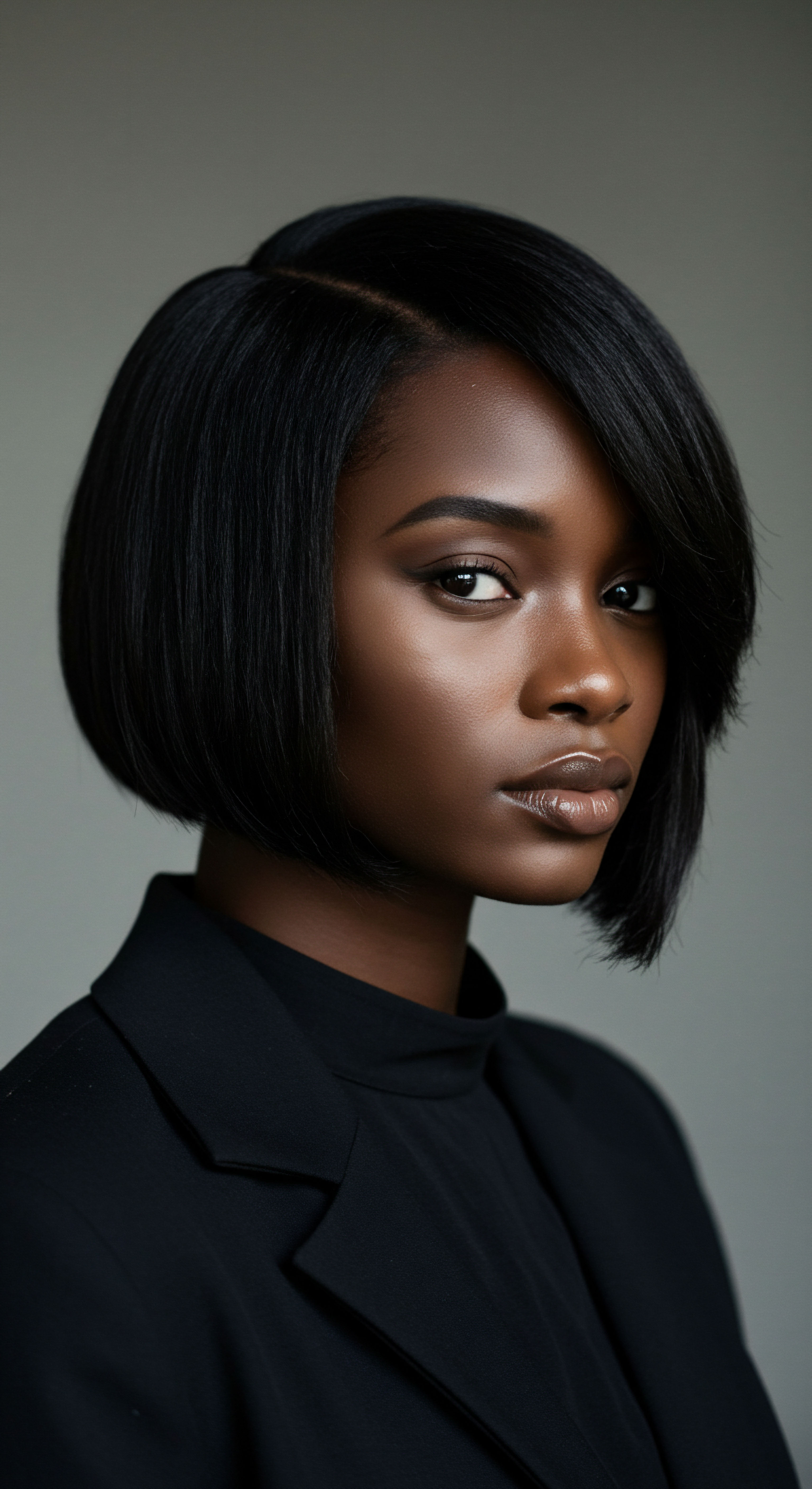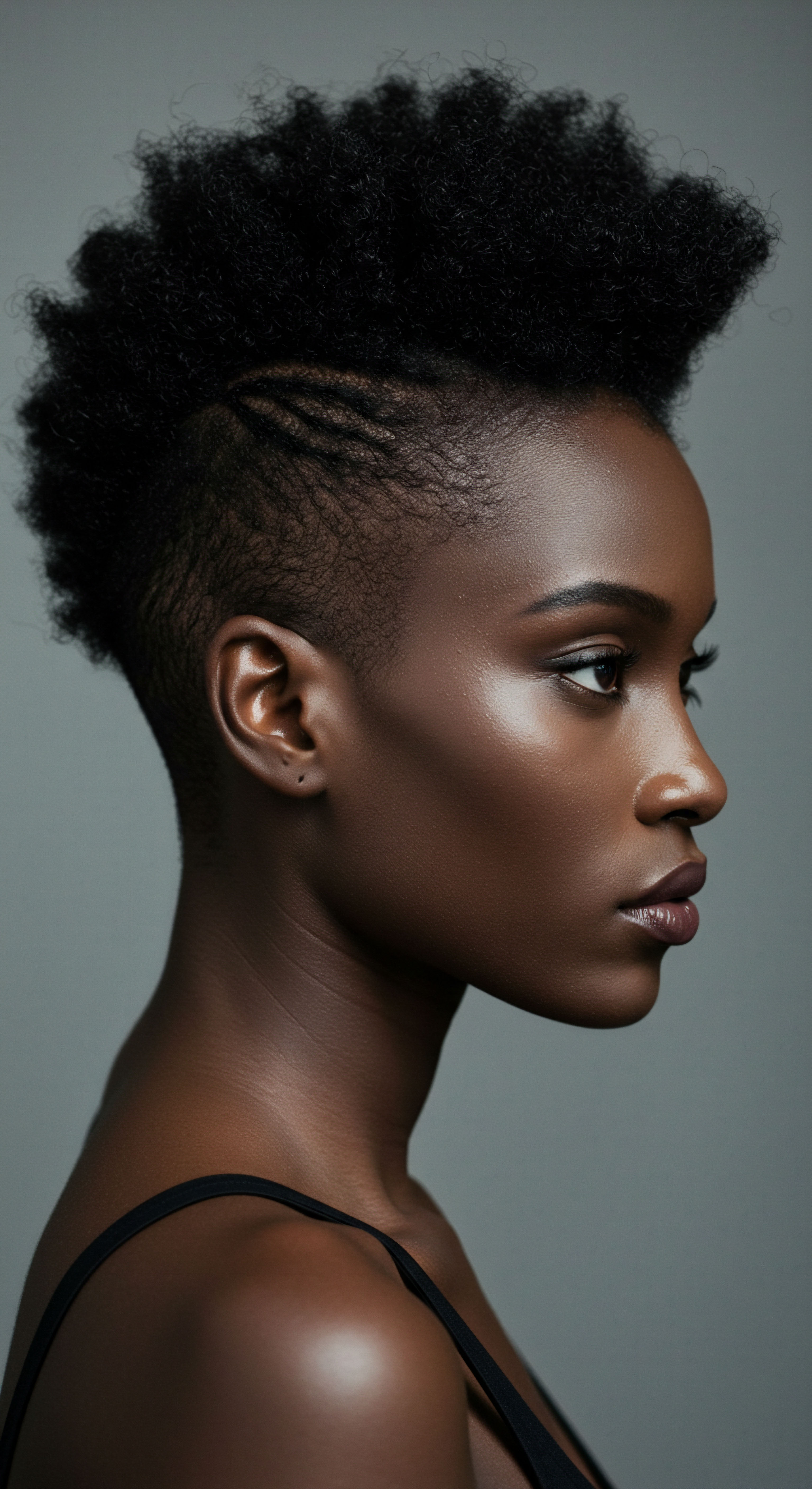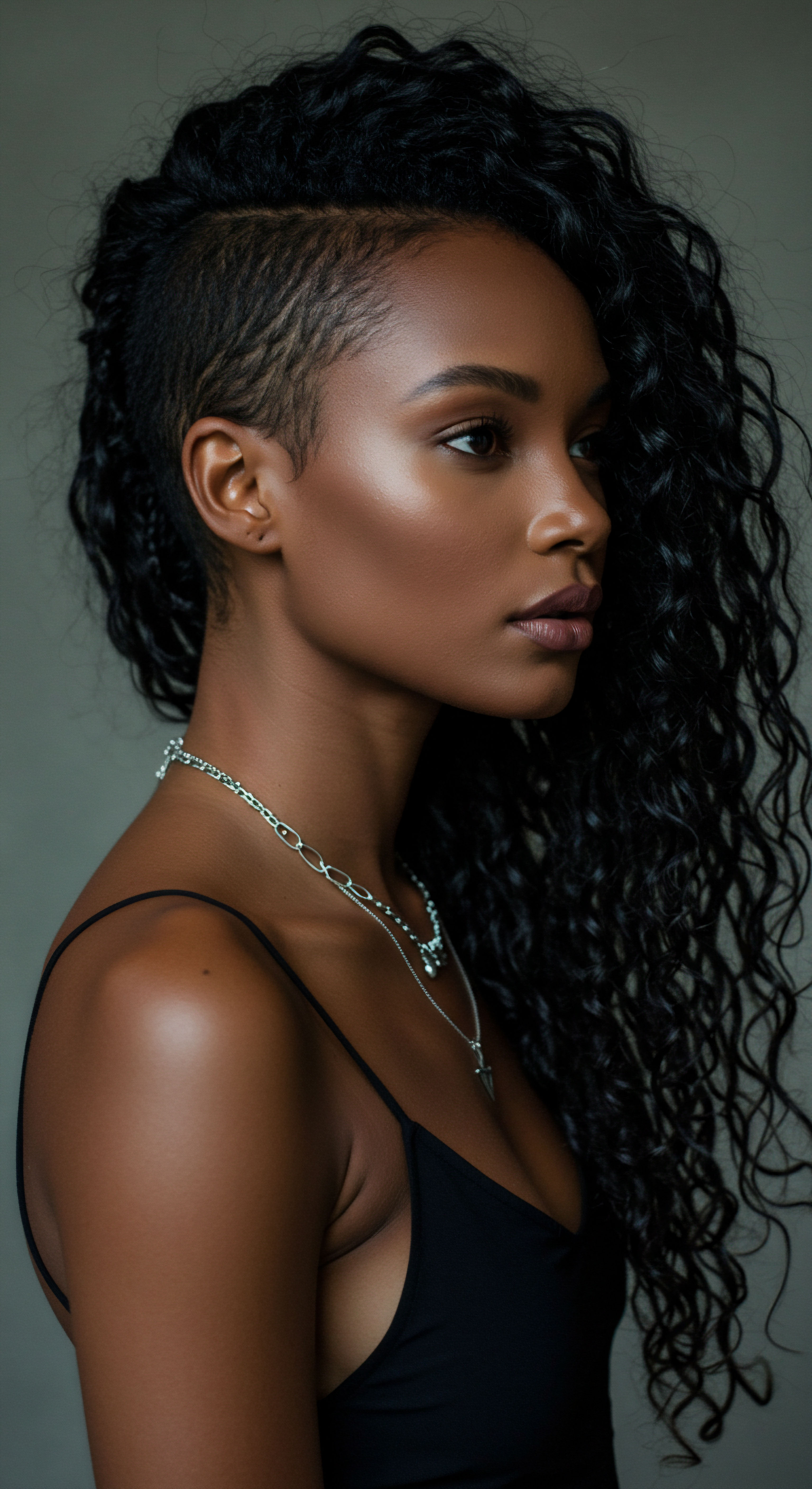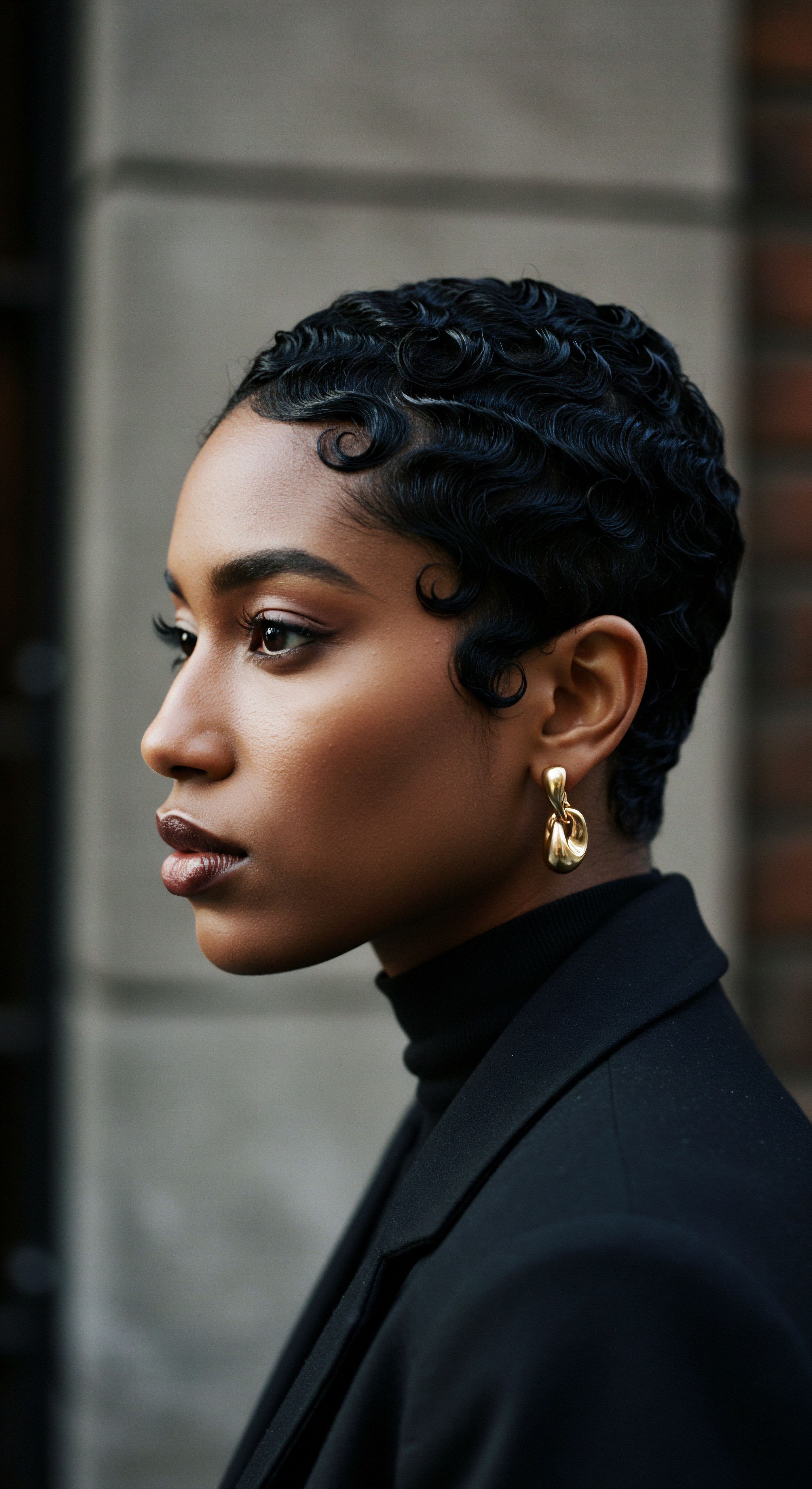
Roots
The quiet inquiry into whether waterless products truly bring hydration to coily hair begins not with a quick answer, but with a gentle turning towards the very essence of these unique strands. One might wonder about the deep thirst coiled hair often expresses, a longing that feels distinct from other hair textures. This longing has roots in the hair’s fundamental structure, a design shaped by heritage and purpose. Understanding the microscopic world of a single coily strand offers a grounding presence, revealing why its care often walks a path less traveled, guided by both ancient wisdom and modern scientific discovery.

The Intricate Design of Coily Hair
Each strand of coily hair is a marvel of biological architecture. Unlike straight or wavy textures, coily strands possess an elliptical cross-section and numerous twists along their length. This unique shape creates points where the outermost protective layer, the Cuticle, naturally lifts away from the hair shaft. Consider the cuticle as a series of overlapping shingles on a roof.
When these shingles are tightly closed and lie flat, moisture struggles to enter, but once inside, it remains held. For coily hair, these “shingles” are often slightly raised or unevenly spaced due to the very nature of the coil itself. This structural characteristic, while beautiful, renders coily hair inherently more susceptible to moisture loss, making it feel dry more quickly than other hair types. This inherent vulnerability underscores the deep need for a thoughtful approach to moisture replenishment.

How Porosity Shapes Hair’s Thirst
Hair porosity describes how well your hair absorbs and retains moisture. It is a concept central to understanding the true needs of coily hair. Porosity is primarily determined by the condition of the cuticle layer. There are generally three categories, though individual experiences may span a spectrum.
- Low Porosity Hair has tightly packed cuticles, making it difficult for water and products to enter. Once moisture penetrates, however, it tends to stay well contained. This hair often repels water, takes longer to wet, and can show product sitting on its surface.
- Normal Porosity Hair displays a balanced cuticle structure, allowing for good absorption and retention of moisture. It responds well to various products and styling techniques.
- High Porosity Hair, characterized by gaps or raised cuticles, absorbs moisture quickly but loses it with equal speed. This often results in hair that feels dry and prone to frizz. Damage from heat, chemical treatments, or environmental elements can also raise the cuticle, shifting hair towards higher porosity.
For coily hair, a predisposition to higher porosity or areas of raised cuticle means a continuous dialogue with the environment regarding moisture. The tight bends of the coils themselves can contribute to cuticle lifting, regardless of external damage. This inherent structural characteristic means that water, while essential, can also escape rapidly, leaving the hair feeling parched shortly after wetting.

The Water Paradox ❉ A Deeper Look
Hair contains approximately 25% water, a vital component for its strength and suppleness. Water molecules are small enough to penetrate the cuticle, offering hydration and influencing the hair’s volume and shine. Properly moisturized hair displays increased elasticity, offering greater resistance to the daily rigors of combing, styling, and heat. A study by Procter & Gamble showed that hydrating hair can increase its resistance to breakage by up to 30%.
This highlights the direct connection between water content and the physical resilience of the hair strand. Yet, the paradox remains ❉ if coily hair so readily absorbs water, why does it so quickly feel dry?
Coily hair’s unique structure, with its naturally lifted cuticles, makes it particularly vulnerable to rapid moisture loss, underscoring a constant need for deliberate hydration strategies.
The answer lies in the swift evaporation that follows absorption, especially for hair with more open cuticles. This phenomenon, often referred to as transepidermal water loss (TEWL) when discussing skin, also has parallels in hair, where water quickly departs from the strand. The goal, then, is not simply to introduce water, but to assist the hair in holding onto it, creating a lasting sense of quench. This understanding guides the formulation of products, including those that are waterless, to work in concert with the hair’s inherent needs.

Ritual
Moving from the foundational understanding of coily hair, we turn our attention to the practices and preparations that define its care. The question of waterless products finds its place within this realm of deliberate action, offering a different approach to nurturing these strands. This segment invites a look at the tools and techniques that shape a regimen, guiding the hair towards a state of enduring hydration with gentle, knowing hands.

Unpacking Waterless Formulations
The term “waterless” in hair products can sometimes lead to misunderstanding. It does not mean the hair receives no water at all. Rather, it indicates that the product itself is formulated without water as a primary ingredient, presenting active components in a more concentrated form.
These products often come as balms, oils, powders, or solid bars, differing from traditional liquid conditioners or creams. The intention behind these formulations is to deliver potent ingredients directly, often relying on the user to introduce water to the hair before or during application, or for the ingredients to draw moisture from the environment.
For coily hair, this distinction holds particular significance. Since coily strands are prone to rapid water loss, applying a concentrated, waterless product to hair that is already damp or lightly misted can allow the product’s beneficial components to work synergistically with the existing moisture. This approach seeks to seal in the water that is already present or freshly introduced, rather than relying on the product itself to be the sole source of hydration.

The Three Pillars of Moisture Retention
Effective hair hydration relies on a concerted effort from three distinct, yet complementary, categories of ingredients ❉ humectants, emollients, and occlusives. Waterless products often excel in delivering the latter two, while sometimes incorporating humectants that draw moisture from the air.
- Humectants are substances that attract water molecules from the air or from deeper layers of the skin and hair. Glycerin, hyaluronic acid, and honey are examples often found in hair care. For humectants to truly benefit coily hair, especially in a waterless product context, they need a humid environment or an accompanying occlusive to prevent the drawn moisture from simply evaporating away.
- Emollients are designed to soften and smooth the hair’s surface. They often consist of plant oils and butters, such as shea butter or cocoa butter, which fill in gaps and rough spots on the cuticle, making the hair feel softer and appear shinier. These ingredients contribute to the hair’s suppleness and pliability, reducing friction and aiding in detangling.
- Occlusives form a protective barrier on the hair strand, effectively sealing in moisture and reducing its escape into the atmosphere. Ingredients like petrolatum, mineral oil, and certain waxes function as strong occlusives. Many plant-based butters, such as shea butter, also possess significant occlusive properties. For coily hair, which struggles with moisture retention, the barrier created by occlusives is particularly helpful in prolonging hydration.
Waterless products frequently concentrate on emollients and occlusives, providing a rich, dense application that coats the hair, assisting in locking in any pre-existing moisture. This concentration means a little product can often accomplish a great deal, providing substantial coating without the dilution of water.

Can Waterless Balms Quench Coily Hair’s Thirst?
The core question of whether waterless products truly hydrate coily hair finds its answer in how these products are formulated and how they are used. A waterless hair balm, for instance, typically contains a rich blend of butters and oils, acting primarily as emollients and occlusives. When applied to damp coily hair, these balms do not directly add water to the hair shaft.
Instead, they form a substantial seal over the cuticle, trapping the water already present within the strand. This creates a moist environment beneath the product layer, allowing the hair to remain hydrated for a longer period.
Some waterless formulations may also contain humectants. These ingredients, in a humid environment, can draw water from the air into the hair shaft, which is then held by the occlusive elements of the product. This dual action can offer a unique hydration experience, especially for those living in climates with ample atmospheric moisture.
Consumer experiences with waterless hair balms often report a reduction in frizz and an increase in softness and shine for thick or coily hair. This suggests that while they do not deliver water in the traditional sense, they are effective at preserving existing moisture and improving the hair’s tactile qualities.
Waterless products, often rich in emollients and occlusives, excel at sealing in existing moisture, making them effective partners for damp coily hair in its quest for lasting hydration.
The effectiveness of waterless products for coily hair often depends on the application method. Applying them to freshly washed, damp hair, or after a light misting, ensures that there is water to be sealed in. This approach aligns with the well-known “LOC” or “LCO” method (Liquid, Oil, Cream / Liquid, Cream, Oil), a popular layering technique in textured hair care that prioritizes water application before sealing agents. Waterless balms or oils effectively replace the “Oil” or “Cream” step, providing the necessary barrier to prevent moisture escape.

Relay
Stepping beyond the immediate practices, we now move to a more expansive view, connecting the present discussion of waterless products to the enduring wisdom of past generations and the rigorous scrutiny of modern inquiry. This section aims to provide a sophisticated understanding, drawing connections across disciplines and time, to fully comprehend the intricate interplay of science, culture, and care for coily hair.

Echoes of Ancestral Practices in Modern Care
The principles behind waterless or water-light hair care are not novel; they echo practices observed in various cultures for centuries. Long before modern cosmetic science, communities around the world, particularly in Africa, relied on natural butters, oils, and plant extracts to care for and protect textured hair. These traditional methods often centered on preserving the hair’s natural moisture and protecting it from environmental stressors, rather than solely on cleansing with abundant water.
For example, shea butter, revered across West Africa, has been used for centuries as a moisturizer for both skin and hair, valued for its rich fatty acid and vitamin content, and its ability to protect hair from sun and environmental damage. Chadian women traditionally used Chébé powder, often mixed with moisturizing substances like shea butter, applied to already hydrated hair, and then braided to lock in moisture. These historical practices demonstrate a deep understanding of sealing in moisture with lipid-rich ingredients, a concept that finds its parallel in today’s waterless formulations that prioritize emollients and occlusives.
The modern LOC (Liquid, Oil, Cream) or LCO (Liquid, Cream, Oil) methods, widely adopted in textured hair care, serve as a direct continuation of these ancestral principles. They acknowledge the primary role of water for hydration, followed by the strategic layering of oils and creams to seal that water within the hair shaft. Waterless balms and concentrated oils fit seamlessly into the “Oil” or “Cream” steps, providing a potent dose of sealing agents. This continuity highlights that the wisdom of retaining moisture, rather than simply applying it, has always been central to caring for coily textures.

The Science of Strand Resilience ❉ Data and Deep Dive
Scientific investigation offers further layers of understanding regarding coily hair’s unique hydration needs and the efficacy of different care approaches. While conventional wisdom sometimes suggests that more hydrated hair is rougher to the touch, research at TRI Princeton indicates a different reality for coily hair. Their studies suggest that Increased Water Content might Be a Good Thing for Coily Hair and may Help Prevent Hair Breakage. This finding challenges assumptions often drawn from studies on straighter hair types and underscores the distinct biomechanical properties of coily strands.
The structural characteristics of coily hair, with its inherent twists and often elliptical cross-section, make it more susceptible to mechanical stress. A study on curly hair demonstrated that Combing can Require 5 to 50 Times the Force Needed for Straight Hair. This increased fragility means that strategies that reduce friction and improve elasticity, such as those provided by proper hydration and a protective barrier, are paramount. Waterless products, by offering concentrated emollients and occlusives, contribute to this protective layer, making hair smoother and less prone to mechanical damage.
Dr. Michelle Gaines, a polymer chemist and materials scientist at Spelman College, highlights a historical knowledge gap in hair research, noting that most prior studies focused on wavy or straight strands. Her team’s work is addressing this, seeking to define measurable properties of coily hair to better inform product development.
Preliminary findings from her research suggest that cuticle layers are larger and spaced further apart in wavy hair compared to curly and coily hair, which helps to explain why Curly and Coily Locks Tend to Dry Out Faster. This scientific backing validates the lived experience of many with coily hair and supports the need for products that actively work to counteract this rapid moisture loss, such as concentrated waterless formulations that seal the cuticle.
| Property Elliptical Cross-Section and Twists |
| Implication for Hydration Cuticles naturally lift, leading to increased moisture escape. |
| Role of Waterless Products Provide a sealing barrier to reduce evaporation. |
| Property Higher Porosity Tendency |
| Implication for Hydration Absorbs water quickly but loses it rapidly. |
| Role of Waterless Products Offer concentrated occlusives to lock in water. |
| Property Increased Mechanical Fragility |
| Implication for Hydration Requires significant force to comb, prone to breakage. |
| Role of Waterless Products Emollients soften strands, reducing friction and aiding detangling. |
| Property Understanding these properties informs effective care, where waterless formulations serve a specific and supportive role. |

The Scalp’s Silent Dialogue with Hydration
While the hair strand is our primary focus, the health of the scalp plays an equally significant role in overall hair well-being and its ability to maintain moisture. The scalp, like the rest of our skin, undergoes transepidermal water loss (TEWL), a natural process where water evaporates from its surface. Maintaining a healthy scalp barrier helps regulate this water loss. Interestingly, a study on women wearing hijabs found that more frequent hair washing significantly increased scalp TEWL, but did not significantly alter scalp hydration levels.
This suggests that while external factors can influence the scalp’s barrier function, the scalp’s inherent hydration mechanisms may remain resilient, or other factors are at play. This nuanced understanding reminds us that scalp health is a distinct, yet interconnected, aspect of hair hydration.
Waterless products, particularly those designed for the scalp, can contribute to a healthy environment by providing concentrated nutrients and lipids without the potential drying effects of frequent water exposure and subsequent rapid evaporation. Some waterless formulations, especially those with plant-based ingredients, aim to nourish the scalp directly, supporting its natural barrier function and indirectly assisting in creating a favorable environment for hair growth and moisture retention at the root.

Rethinking Hydration Paradigms for Coily Hair
The journey to truly hydrate coily hair is a multifaceted one, moving beyond simplistic notions of simply “adding water.” It requires a sophisticated understanding of the hair’s unique structure, its inherent porosity, and the dynamic interplay of humectants, emollients, and occlusives. Waterless products, when viewed through this lens, emerge not as a replacement for water, but as powerful allies in the larger strategy of moisture retention. They provide the concentrated sealing and softening agents that coily hair so desperately needs to hold onto the water it absorbs, transforming fleeting dampness into enduring suppleness.
Coily hair’s resilience hinges on strategies that go beyond simple water application, emphasizing moisture retention through intelligent product design and application.
The shift towards waterless formulations also aligns with a growing appreciation for ingredient purity and environmental consciousness. By removing water, manufacturers can offer more concentrated products, potentially reducing the need for certain preservatives and minimizing packaging waste. For the consumer, this means a more potent product, often requiring less quantity for effect, and a greater awareness of the specific ingredients being applied.
This mindful approach to product selection, combined with an understanding of how these concentrated formulations interact with the unique needs of coily hair, allows for a more effective and harmonious hair care regimen. The ultimate goal is not just to wet the hair, but to nurture its inherent beauty, allowing its coils to flourish with a lasting, deep quench.

Reflection
The question of waterless products and coily hair hydration ultimately opens a dialogue far grander than mere product efficacy. It speaks to the ongoing conversation between scientific understanding and lived experience, between ancestral wisdom and modern innovation. The delicate balance of moisture, the intricate dance of the cuticle, and the profound longing for sustained softness in coily strands all invite a deeper connection to our hair’s true needs. Perhaps the most significant lesson is that hydration for coily hair is not a singular event, but a continuous act of thoughtful attention, a rhythmic response to its unique voice, guiding us toward a more harmonious relationship with our crown.

References
- Gopalakrishnan, M. et al. “Moringa Oleifera ❉ A Review of its Medical, Therapeutic and Cosmetic Applications.” Journal of Ethnobiology and Ethnomedicine, 2016.
- Kim, H. R. et al. “Effects of Ultrasonic Treatment on Hair Moisture Retention.” Journal of Cosmetic Dermatology, 2019.
- Evans, T. “True Porosity Measurement ❉ A New Way to Study Hair Damage Mechanisms.” Journal of Cosmetic Science, 2008.
- Partee, J. “The History of Hair Porosity in Hair Care.” Trichology Today, 2019.
- Rele, S. R. and Mohle, R. B. “Effect of Mineral Oil, Sunflower Oil, and Coconut Oil on Prevention of Hair Damage.” Journal of Cosmetic Science, 2003.
- Adlam, K. et al. “The Impact of Hydration on the Mechanical Properties of Textured Hair.” International Journal of Cosmetic Science, 2021.
- Gavazzoni Dias, M. F. R. “Hair Cosmetics ❉ An Overview.” International Journal of Trichology, 2015.
- Robins, C. R. “The Chemistry of Hair Care.” Marcel Dekker, 2002.
- Hotz, S. et al. “The Biomechanics of Human Hair.” Skin Research and Technology, 2018.
- Draelos, Z. D. “Cosmetic Dermatology ❉ Products and Procedures.” Wiley-Blackwell, 2015.